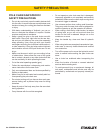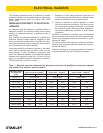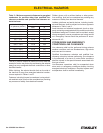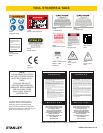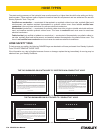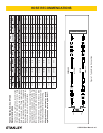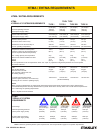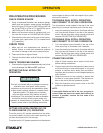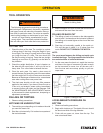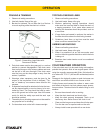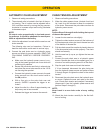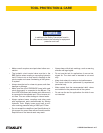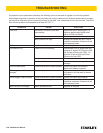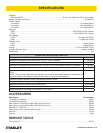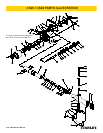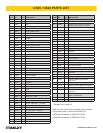
14 ► CS25/28 User Manual
4.
WARNING
Watch for falling limbs.
Make a diagonal cut down to meet the horizontal cut
and remove the wood from the notch.
FELLING OR BACK CUT
5. The felling or back cut is made on the side opposite
and at least 2 inches above the horizontal undercut
(the felling cut is made higher as the size of the tree
increases).
6. Start the cut horizontally parallel to the notch cut.
Cut until the saw is about 1 or 2 inches from the
notch. DO NOT CUT THROUGH THE NOTCH.
NOTE:
The uncut wood between the felling and notch cuts
is called the hinge. The hinge controls the fall of the
tree and should be of uniform thickness.
7. As the saw nears the back cut, watch the tree-top
and the cut for signs of movement. Be alert as soon
as the tree starts to move, turn off the saw, pull it
from the tree and move away quickly on your es-
cape route.
Figure 2. Felling a Tree
LOGS/LIMBS WITH PRESSURE ON
BOTTOM
1. Observe all safety precautions.
2. Begin with a bottom-cut. The depth of the cut should
be about one-third of the log diameter.
3. Finish with an upper cut, down from the top. The
saw cuts should meet.
TOOL OPERATION
WARNING
The following are general woodcutting procedures
and techniques. Differences in the terrain, vegetation
and type of wood will make this information more or
less valid for particular areas. For advice on specic
wood cutting problems or techniques for your area,
consult you local Stanley representative or your
county agent. They can often provide information
that will make your work safer and more productive.
CUTTING TIPS
1. Check the lean of the tree. Tie a weight to a piece
of string about 2 feet long. Hang the weight in your
line of sight. The string is a good vertical line to help
you judge the lean of a tree. The tree should fall
the way the string is leaning. Trees that are straight
(leaning no more than 5°) generally can be felled in
any direction.
2. Check the weight distribution. A tree is heavier on
the side with the most limbs. It will try to fall on its
heavy side. Trim a few limbs to balance the tree.
3. Clear the work area. You need a clean area all
around the tree. Get everything out of the area where
the limbs might fall. Do not cut trees near structures.
Because of the danger of electrocu tion, use extreme
care when cutting trees near power lines.
4. The chain saw should cut with very little pressure
applied to the handle. If you have to force the cut or
if the cut is not straight, cease cutting immediately
to prevent further saw chain and bar damage. See
the MAINTENANCE AND ADJUSTMENTS section
in this manual for chain replacement, sharpening or
adjustment proce dures.
FELLING OR TOPPING
1. Observe safety precautions.
NOTCHING OR UNDERCUTTING
2. The notching or undercutting cut is made on the side
you want the tree to fall.
3. Start the cut horizontally. Cut to about one-quarter of
the tree’s diameter.
OPERATION



